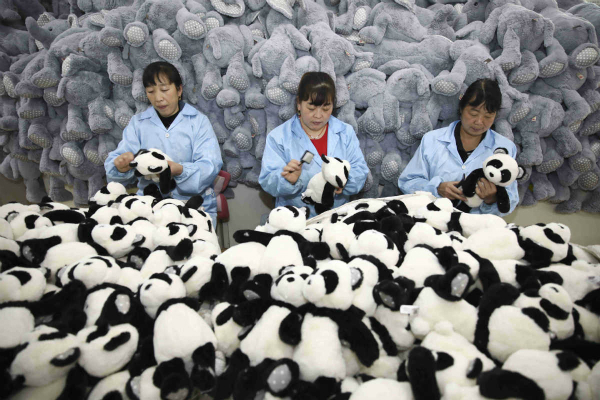November's foreign trade up 7.8%; growth stabilizes

Workers in Lianyungang, Jiangsu province, make Christmas toys on Oct 29 for export to the United States and European markets. [Si Wei/for China Daily]
China's foreign trade will maintain stable growth this year thanks to its reliable supply chains, efficient manufacturing operation and major trading partners' better-than-expected economic performance, officials and analysts said on Monday.
The recent signing of the Regional Comprehensive Economic Partnership agreement, together with the country's new round of opening-up and reform, will also put foreign trade growth on firmer footing amid the COVID-19 pandemic, experts said.
Because of China's early recovery from the pandemic and the government's supportive policies, the nation's foreign trade sustained upward momentum in the third quarter of this year, with notable growth and improved structure, said Zhang Yongjun, a researcher at the China Center for International Economic Exchanges in Beijing.
The country's foreign trade expanded 7.8 percent year-on-year in November, with exports jumping 14.9 percent on a yearly basis and imports declining 0.8 percent, Customs data showed.
Wang Dan, chief economist at Hang Seng Bank (China), said China's export performance once again beat market expectations, mainly due to the holiday demand surge from the developed markets.
Apart from helping to mend disrupted global supply chains, China's soaring foreign trade will effectively fuel its economic growth and make the country the first major economy to recover from the impact of the COVID-19 pandemic, said Yang Zhengwei, deputy director-general of the Ministry of Commerce's Department of International Trade and Economic Affairs.
Because of the complementary industrial structures between China and the European Union and enhanced business ties driven by factors such as the accelerated pace of China-EU investment treaty talks and booming China-Europe freight train services, China replaced the United States as the EU's largest trade partner in the third quarter, reflecting the resilience and potential of bilateral economic and trade ties, the Foreign Ministry said last week.
China's foreign trade with the Association of Southeast Asian Nations, its largest trading partner, jumped 6.7 percent year-on-year to 4.24 trillion yuan from January to November, while its trade volume with the EU, its second-largest trading partner, grew 4.7 percent year-on-year to 4.05 trillion yuan.
Meanwhile, China's trade in goods with the US soared 6.9 percent year-on-year to 3.65 trillion yuan.
In addition to Chinese exporters, many multinational companies such as Siemens, Caterpillar, Toyota Motor and Schneider Electric have pledged to enhance productivity or export more products made from their plants in China to other parts of the world over the next few years, as they think highly of China's response to the coronavirus pandemic and its continuous efforts to facilitate trade and investment activities.
Sunvim Group, a textile product manufacturer in Shandong province, said its business outlook was cloudy in the first quarter of the year, when COVID-19 started to cripple the global economy, and then took a turn for the better starting in April, since many overseas manufacturers in that sector have either suspended their production or shut their factories to avoid health risks.
Although Sunvim's towel exports to Japan accounted for 53 percent of China's total towel exports to the country in the first three quarters, it paid tariffs to Japanese Customs and meanwhile saw its competitors in Vietnam paying zero tariffs to ship their goods to Japan, due to the two countries' free trade agreement.
Xiao Maochang, Sunvim's chairman, said this situation will change greatly as member countries of the RCEP trade deal will aim to cut tariffs to zero in the coming decade.
























